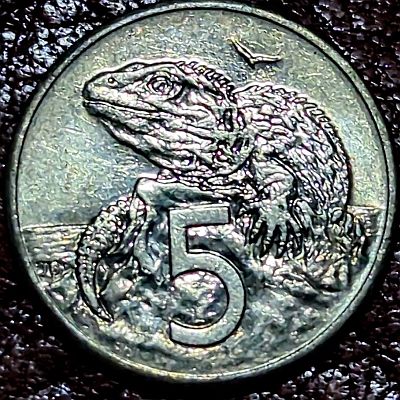A coin featuring a living dinosaur

The obverse of the coin, like all New Zealand coins from 1986 – 1998 features the 3rd portrait of Queen Elizabeth II, designed by Raphael David Maklouf. Australia used the same portrait from 1985 – 1988.

The reverse features the tuatara, a fascinating creature from the time of the dinosaurs. Tuatara are New Zealand’s largest reptile. Adult males are about 0.5 metres in length, and weigh up to 1.5 kg when fully grown. The colour of tuatara ranges from olive-green, to brown, to orange-red. They can also change colour over their lifetime. They shed their skin once per year.
Although it looks like a lizard, it really is quite different. Found in New Zealand only, the tuatara’s closest relatives are an extinct group of reptiles from around the time of the dinosaurs. Their most curious body part is a “third eye” on the top of the head. The “eye” has a retina, lens, and nerve endings, yet it is not used for seeing. It is visible under young tuataras’ skin but becomes covered with scales and pigment in a few months, making it hard to see. The unique eye is sensitive to light and may help the tuatara judge the time of day or season.
Unlike all other living toothed reptiles, the tuatara’s two rows of top teeth, overlapping one lower row, are fused to the jaw bone.

A fascinating and unique animal. Thanks New Zealand!


Leave a Reply